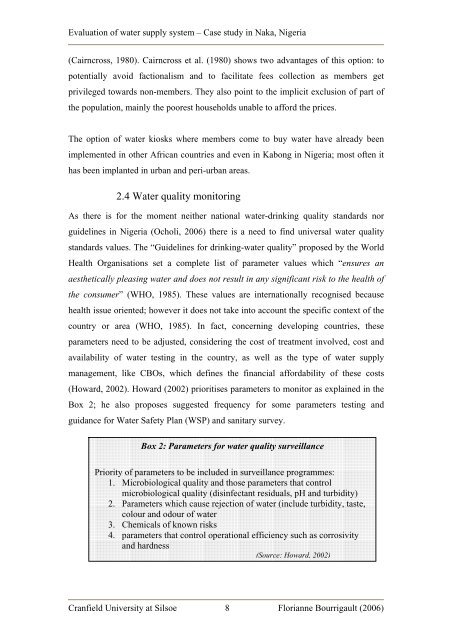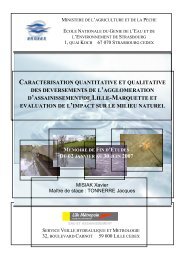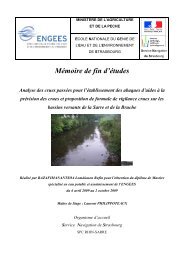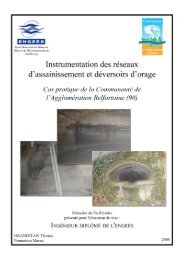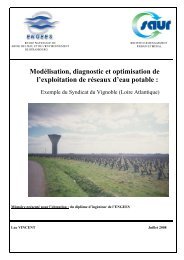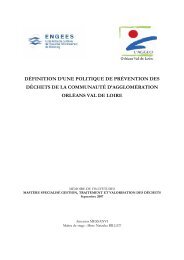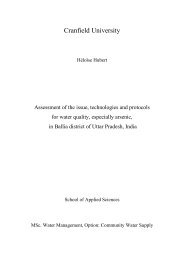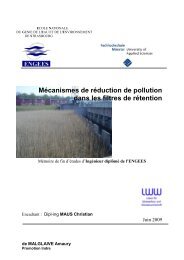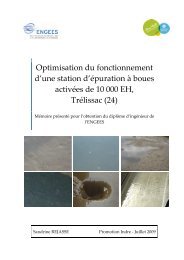Evaluation of water supply system Case study in Naka ... - ENGEES
Evaluation of water supply system Case study in Naka ... - ENGEES
Evaluation of water supply system Case study in Naka ... - ENGEES
- No tags were found...
Create successful ePaper yourself
Turn your PDF publications into a flip-book with our unique Google optimized e-Paper software.
<strong>Evaluation</strong> <strong>of</strong> <strong>water</strong> <strong>supply</strong> <strong>system</strong> – <strong>Case</strong> <strong>study</strong> <strong>in</strong> <strong>Naka</strong>, Nigeria(Cairncross, 1980). Cairncross et al. (1980) shows two advantages <strong>of</strong> this option: topotentially avoid factionalism and to facilitate fees collection as members getprivileged towards non-members. They also po<strong>in</strong>t to the implicit exclusion <strong>of</strong> part <strong>of</strong>the population, ma<strong>in</strong>ly the poorest households unable to afford the prices.The option <strong>of</strong> <strong>water</strong> kiosks where members come to buy <strong>water</strong> have already beenimplemented <strong>in</strong> other African countries and even <strong>in</strong> Kabong <strong>in</strong> Nigeria; most <strong>of</strong>ten ithas been implanted <strong>in</strong> urban and peri-urban areas.2.4 Water quality monitor<strong>in</strong>gAs there is for the moment neither national <strong>water</strong>-dr<strong>in</strong>k<strong>in</strong>g quality standards norguidel<strong>in</strong>es <strong>in</strong> Nigeria (Ocholi, 2006) there is a need to f<strong>in</strong>d universal <strong>water</strong> qualitystandards values. The “Guidel<strong>in</strong>es for dr<strong>in</strong>k<strong>in</strong>g-<strong>water</strong> quality” proposed by the WorldHealth Organisations set a complete list <strong>of</strong> parameter values which “ensures anaesthetically pleas<strong>in</strong>g <strong>water</strong> and does not result <strong>in</strong> any significant risk to the health <strong>of</strong>the consumer” (WHO, 1985). These values are <strong>in</strong>ternationally recognised becausehealth issue oriented; however it does not take <strong>in</strong>to account the specific context <strong>of</strong> thecountry or area (WHO, 1985). In fact, concern<strong>in</strong>g develop<strong>in</strong>g countries, theseparameters need to be adjusted, consider<strong>in</strong>g the cost <strong>of</strong> treatment <strong>in</strong>volved, cost andavailability <strong>of</strong> <strong>water</strong> test<strong>in</strong>g <strong>in</strong> the country, as well as the type <strong>of</strong> <strong>water</strong> <strong>supply</strong>management, like CBOs, which def<strong>in</strong>es the f<strong>in</strong>ancial affordability <strong>of</strong> these costs(Howard, 2002). Howard (2002) prioritises parameters to monitor as expla<strong>in</strong>ed <strong>in</strong> theBox 2; he also proposes suggested frequency for some parameters test<strong>in</strong>g andguidance for Water Safety Plan (WSP) and sanitary survey.Box 2: Parameters for <strong>water</strong> quality surveillancePriority <strong>of</strong> parameters to be <strong>in</strong>cluded <strong>in</strong> surveillance programmes:1. Microbiological quality and those parameters that controlmicrobiological quality (dis<strong>in</strong>fectant residuals, pH and turbidity)2. Parameters which cause rejection <strong>of</strong> <strong>water</strong> (<strong>in</strong>clude turbidity, taste,colour and odour <strong>of</strong> <strong>water</strong>3. Chemicals <strong>of</strong> known risks4. parameters that control operational efficiency such as corrosivityand hardness(Source: Howard, 2002)Cranfield University at Silsoe 8 Florianne Bourrigault (2006)


